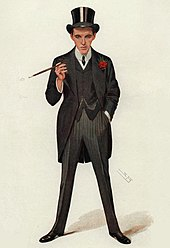The Truth Behind Nursery Rhymes
By C. A. Asbrey
Blue plaques in the UK are used to commemorate the birthplaces and residences of all kinds of historical figures. Notably, fictional characters are not eligible to be honoured in such a way. The picture above from Glasgow is a bit of Scottish whimsy, as Wee Willie Winkie was not actually a real boy so it's not official, but it's one of the best-known Scots poems to be translated into English, the other being Auld Lang Syne. William Miller (1810-1872) followed in the long tradition of adapting traditional material with updated lyrics, something commonly done in Scotland for centuries, with the tale of a rambunctious child wandering the streets and causing havoc because he refuses to go to sleep. And in this case, despite rumours of him representing a couple of famous disrupting figures, Willie is exactly who he was written to be; a small boy who didn't want to go to bed, and his antics are purely for entertainment.

But what about many others? John Bellenden Ker (1764-1842) was an English botanist who was one of the very few to formally study nursery rhymes. Archaeology of Popular Phrases and Nursery Rhymes was published in 1837, in which he claimed that older rhymes were written in Low Saxon, an early form of Dutch. He 'translated' them back, changing them slightly at that time, but mostly that didn't work as a methodology. Other studies have shown that the oldest tend to be lullabies, and the rest fall under the following categories; political, reflecting actual people, protest, propaganda, social observations, and just plain entertainment. There are far too many to examine all of them, but by splitting it down into categories, I can give a few examples of the changing forms and histories these rhymes and ditties had in the past.
The word Lullaby is onomatopoetic and comes from the sounds women historically made soothing infants. The Roman nurses' lullaby, "Lalla, Lalla, Lalla, aut dormi, aut lacta", is recorded in a scholium on Persius (c. 380) and may be the oldest we have. Rock-a-Bye Baby is one of the most famous lullabies, and has multiple versions, and many supposed backgrounds. One says that it relates to early settlers in America watching how local native women used trees to sooth their babies, another that it lampoons James II and is about the hope of his political enemies that his child would die, or that it's a poor French translation. The first printed version appeared in A Compilation of English rhymes, Mother Goose's Melody, or, Sonnets for the Cradle (London, 1780) and has different words to another famous version. The King James theory is seen by many as the most likely as there was a tradition of hating or adoring a leader through verses obscure enough to give plausible deniability if arrested for sedition, and the timeline matching James II is right for its rising popularity. Two obituaries in the early twentieth century, one for an actress and the other for a music publisher in new York, claim that they both wrote it, but as it predates them, those appear to be spurious attributions. It does look like Rock-a-Bye Baby is both a lullaby and a protest song.
Most nursery rhymes were written down in the 18th century when it became fashionable to capture entertaining songs and poems on sheets for sale to the masses and to write for entertainment, but the majority are definitely far older than that. One of the most popular is Ring-a-Ring-a-Roses and rumours associate it with the great plague, with the ring representing the circular welts, the sneezing and falling down relating to the symptoms and early death of plague victims, while the roses said to be the bouquets people used to ward off the evil smells they thought brought disease. However, there are European versions with the same rhythm and actions, but with different lyrics that seem to contradict this theory. Another myth says it is about when the Protestants banned dancing in England, but the spread of the ditty through Europe tells us that it predates that too. All iterations have children dancing in a ring around various shrubs; roses, mulberry bushes, and even apricots, so it seems unlikely that the plague was what inspired it as folklorists insist that the versions are older than the bubonic plague. In fact, the manifestation of so many versions scattered across Europe speaks of a much more ancient root, transmitted as languages spread and people migrated. The Dictionary of British Folklore and Jacob Grimm's Deutsche Mythologie considered the poem to have pagan roots, and may even be echoes of some kind of spell or ritual. The studies cited an old iteration passage which reads "Gifted children of fortune have the power to laugh roses, as Freyja wept gold." In much of European paganism roses represented female power, and the falling down seems to have originally been a simple courtesy or bow. In some of the versions a popular girl would be chosen to be danced around then bowed to, representing the honouring of some kind of female figure. Perhaps the oldest nursery rhyme still in use, and some studies relate it to pagan Beings of Light mythologies, which may explain why so many dance around types of plants. Plants were perceived as containing spirits and there are many rituals designed to welcome back the gods and goddesses of light after the winter darkness. Most sources say that the rhyme didn't get into print in Britain until 1881, but had been in writing since at least 1790. We can only guess as children's games were seen as too trivial to be worthy of serious study. All I can suggest is that you take pick of the theories for yourself, but it does seem to fall into the folk history type of rhyme.
 |
| Freya's Tears by Klimt |
It's also likely that this song prevailed as it was used to circumvent a ban on dancing by extreme Protestants in the USA, and in Cromwellian England where the puritans ruled for a time. Children's games were permitted, and in the USA they had gatherings called 'ring parties' in which such circular dancing was allowed as it took place without musical accompaniment. Both children and adults enjoyed ring parties, and they were a popular in the same way as square dancing later became. People always push the rules as far as they can.
Goosey Goosey Gander is an example of propaganda in a nursery rhyme, and illustrates how language that was pretty blatant in the past becomes arcane in the present. `Goosey Goosey Gander, whither shall I wander? Upstairs and downstairs and in my lady's chamber. There I met an old man who wouldn't say his prayers, so I took him by the left leg and threw him down the stairs.'

In 16th-18th century England, goose meant prostitute. Even today in the UK, to goose someone means to poke them sharply in the buttocks, but in the 16th century 'to be bitten by a goose' meant to contact a venereal disease from a whore. This jaunty poem has been linked to Henry VIII's dissolution of the monasteries following his rejection of the Catholic Church, and later persecution of Catholics. Henry actively undermined the authority of the church by mockery as well as violence, and the connection with Catholicism can be seen by the reference to the old man's left leg as the left leg or left-footer was a term for a Catholic. Even today in Scotland, it's used as a pejorative term for Catholics. And note that the old man wouldn't say his prayers. That's a reference to the refusal to give up their Catholic faith and attend the church of England services. So you can see a firm ploy to connect Catholics with the use of prostitutes while refusing to attend church. You would be right in guessing that these propaganda rhymes were not originally recited by children, but were comic turns in public houses and at drunken gatherings. Once the meanings became more obscure the songs were deemed safe for children to use them as harmless fun or in counting games with hopping, balls, skipping ropes, or games of tag. Sing a Song of Sixpence also relates to the dissolution of the monasteries, and Henry reaping the profits of his cannibalising of everything valuable they had. Henry was also likely to be mentioned as sitting in his counting house, counting out his money, as Henry devalued the coin of England by issuing coins in copper and other base metals at the same face value as gold and silver in an act referred to as the Great Debasement. This caused a crisis of confidence in English currency that lasted until Elizabeth Ist put things right and returned to precious metals. Catherine of Aragon represented the queen in the song, and Anne Boleyn the maid.
A purer example of the protest nursery rhyme is Baa Baa Black Sheep. The rumours that this is any racial element to this ditty are unfounded, and the rhyme was circulating centuries before the slave trade was developed to any size. Sheep were introduced to Britain by the Neolithic pastoralists, a bridge between hunter-gatherers and farmers. These sheep came in various colours, as did others brought by various waves of invasions, but black sheep were not a liability of any kind. In fact, they were as valued by shepherds as the variation in wool colour sold well and took less dyeing. In the 12th and 13th centuries wool was a huge source of wealth for England, making up sixty-five percent of the crown's income. Katherine Elwes Thomas in The Real Personages of Mother Goose (1930) posited that the rhyme was a protest against the heavy taxes on wool, more specifically the medieval English "Great" or "Old Custom" wool tax of 1275, which survived until the fifteenth century. The line, 'one for the master, one for the dame,' refers to the levels of taxation. Out of their produce the equivalent of one third went to the king, (the master), another to the church who owned the land the farmers worked, (the dame, i.e. the Mother Church), and that left only one bag left for the poor shepherd. The tax was around sixty-six percent, hence the protest in song.

There are many nursery rhymes that represent famous or notorious people of the past, and one of the post frequently characterized people was the murderous English queen commonly referred to as Bloody Mary. Mary Ist of England (18 February 1516–17 November 1558) was a Tudor queen with a ferocious reputation. The first woman to claim the throne of England in her own right, she was known for her ruthless suppression of Protestants, and her desire to restore the primacy of the Catholic Church. Her reputation as a bloodthirsty tyrant has been reviewed in modern times in the light of Protestant propaganda, but she certainly did preside over the burning and persecution of Protestants who did not flee the country. So what nursery rhymes are about living under her reign?
Three Blind Mice is said to refer to three Protestant bishops - Hugh Latimer, Nicholas Radley, and The Archbishop of Canterbury, Thomas Cranmer - who were alleged to be involved in a plot to overthrow Mary in favour of her sister, Elizabeth I. They were tortured, dismembered and burned at the stake for their heresy. And then there's Mary, Mary, Quite Contrary. The garden refers to the growing cemeteries, the silver bells were thumbscrews, cockleshells were a torture instrument attached to the genitals. The maids all in a row? Well, the iron maiden was another torture device, and the Scottish maiden was an early guillotine used to behead people.
 |
| Mary Ist of England |
Another nursery rhyme inspired by a person is The Grand Old Duke of York. The problem is that there's dispute about which person. Some say it's about a famous Elizabethan clown Richard Tarlton, as the oldest written version had the title "Old Tarlton's song" and dates back to 1642. He was a member of a troupe called "The Queen's Men", but as people frequently reused old tunes to a set of new words, it's highly likely that even that was a version of an earlier one. There's little doubt that words did change though, as they originally had no connection to York. Depending on the version of the lyrics, we can see that it has been sung of both the Duke of York and the King of France around 1892; from 1894 that it was sung of Napoleon. It has clearly settled on a duke of York, but which one? The most popular attribution is Prince Frederick, Duke of York and Albany (1763–1827), the second son of King George III and Commander-in-Chief of the British Army during the French Revolutionary Wars and the Napoleonic Wars. He led troops with success against the French in the Flanders Campaign, but then had to retreat to the Netherlands. The hill in the rhyme is said to be the town of Cassel that rises 570 feet above the flat fields of Flanders.
So on to the rhymes that reflect social observations that have now become history. Here We Go Round the Mulberry Bush is interesting in that it gives us a detail about a women's prison we'd probably never even know without the song. The 430-year-old Wakefield Prison opened in 1594, and is now a high security prison for men, but it did also used to hold women. And guess where those female prisoners exercised? By walking round and round a large mulberry bush in a yard, and all the descriptions of a regimented way to wash, dress and groom reflect another aspect of prison life.

Another unexpected historical nugget can be found in London Bridge is Falling Down. This is another with versions spread throughout Europe, speaking to a both age and something persistent in the collective folk memory. The oldest version is in 14th century Italy, but the iterations run right across Europe right up to Scandanavia. So what does it really mean? The suggestions that it's about Viking raid in 1014 in London don't fit, not least because the other countries sing about different bridges, and historians suggest that the incident never really took place. Yes, the Vikings did get everywhere, and could have taken the song with them, but wouldn't that make it more likely that it came from their culture and not England? Some say it relates to 1212 Fire of London, in which fire at both ends trapped people on the bridge, while wooden buildings on it caught light. A few escaped on rescue boats, but those trapped were either killed in the fire, caught in a crush to escape, or drowned jumping off. The bridge, however, was made of stone and survived, even though it was only partly usable for years. One very intriguing theory came from Alice Gomme (1853-1938), the noted folklorist. She spoke of an ancient tradition, spread all over the world for immurment, or burying people alive, in the foundations of ancient bridges and grand buildings. There is history that suggests that this changed from burying them alive to killing them to fulfill the tradition. Not only was this supposed to ensure that the structures were meant to remain standing, but that the spirit of the deceased was said to act as a protector. Remember the line 'Set a man to watch all nigh, Watch all night, watch all night, Set a man to watch all night, My fair Lady'? There are stories in Europe of skeletons being found in such circumstances from Ireland to Albania and persist right up to the 1840s. This remained no more than a theory until long after Gommes death. In 2007 skeletons were found by workmen excavating under what remains of the foundations of Old London Bridge. Not only that, but when it was being dismantled in the sixties to be shipped to the USA, multiple skeletons were found inside, including those of women and children. And who was the fair lady? Matilda of Scotland married into the English crown and oversaw the construction of bridges between 1110 and 1118. Eleanor of Provence had custody of the bridge revenues 1269- 1281, a valuable asset as the only bridge across the Thames. She was unpopular and was famously pelted with eggs and stones while passing under the bridge. It could be The Virgin Mary, but if the song was pagan, it could be the spirit of the river. The Lea is a tributary to the Thames and the Leigh family of Stoneleigh Park claims in a traditional family story that they have a family member buried under the bridge as part of a human sacrifice. There are multiple Brythonic deities associated with the Thames, so the fair lady could refer to any of them.

Some of the more modern social observations can be found in rhymes like Pop Goes the Weasel. The rhyme relates to a shopping list and how money ran out before the wages came in at the end of the week. Pop was a slang term for pawning something, and in Cockney rhyming slang a 'weasel and stoat' was a coat, so the words mean that in order to pay for the rice and treacle, the coat had to be pawned. It was not an infrequent occurrence amongst the poor to pawn clothes and other valuables before the wages came in, then redeem them once paid. Music hall jokes were made about the Sunday Best clothes going out for church, and straight back in again like a lending library.
 |
| A Battering Ram Used in an Irish Eviction |
This Old Man was used to teach children to count but also had frightening truth hidden in the words but first of all, what is a paddywack? It's nothing to do with violence towards Irish people. It's a product from the meat industry, the nuchal ligament, that can only be used as a dog chew as it cannot be softened or tenderised. It's also known as a paxwax or backstrap, and is classed as offal. Knick-knacks have also been a term for vertebrae used in the famous game of knucklebones or jacks played since ancient times. It is played the world over and often used angular bones such as vertebrae. Although the current words of the song are more modern, the origins may be quite old, with Welsh versions being recorded. The modern lyrics may be related to the influx of itinerant Irish escaping the potato famine, with journeymen visiting homes to perform services such as repair shoes and household implements, sell knick-knacks, (small objects or cheap ornaments) dog chews, or even perform, to get any money they could. Yes, some poor Irish immigrants often anesthetized the pain of poverty with alcohol, but so did many poor people of all ethnicities in Victorian Britain, and that could be the rolling home in the lyrics.
Another theory relates to the intimidation used to drive the Irish from their native lands. He played knick knack on my thumb meant an eviction notice was pinned to the door with a thumbtack. He played knick knack on my shoe meant that clothes and shoes had to be sold to survive. He played knick knack on my knee meant that anyone fighting the authorities was kneecapped. He played knick knack on my door meant that the door was ripped open and the occupants were forcibly evicted. Hives were a reference to whipping people to chase them away, with the pain stinging. He played knick knack on my sticks is about the landlord's agents damaging the few sticks of furniture people tried to retrieve. Seven and heaven is an obvious allusion to dying and going to the pearly gates, and ten is a prediction that the potato blight would come back again while the paddywhack was all the starving had to chew on. Nick-knacks in this sense are said to be the vertebrae of the dead found in Irish fields for decades after.
We've just sailed through a few of the many famous nursery rhymes we all know, but as I started with pure entertainment as an example, and you do have to go fairly modern to find those. Rhymes like Incy Wincy Spider and the Wheels on the Bus, are fun and have no deep meanings beyond the fun rhythms and repetitions, although the allegorical arachnid could be seen as inspiring persistence. Twinkle Twinkle Little Star can be used to show the hope of light in the darkness, but the reality is that it was just a poem set to the tune of a traditional French folk song. The rumours that Mozart wrote it are unfounded. Versions of Ah! vous dirai-je, maman had been published before he arranged his version of the French love song.

Beyond the history, the hidden meanings, and the obscurity, nursery rhymes serve a useful purpose. They introduce very young children to simple stories, are important for language development and social skills, they teach new sounds and words, and the phonological awareness brought by repetition helps infants to understand sentence structure. The movements and actions help with motor and social skills while strengthening the bond with the parents.
Most of all, they are just a lot of fun, and i hope you had fun reading about a dive into just a few of the most famous.




























